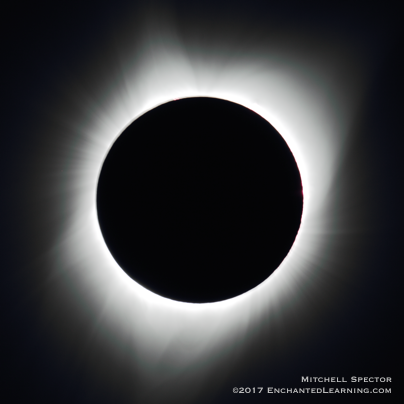Enchanted Learning traveled to Oregon for the Great American Total Solar Eclipse in 2017 — complete with photos and information.
The Great American Eclipse
The solar eclipse of August 21, 2017, has been dubbed the Great American Eclipse, since totality could be seen coast-to-coast across the US, in a band about 65 miles wide going from Oregon to South Carolina (weather permitting, of course). This was the first total solar eclipse visible anywhere in the US mainland since 1979.
Getting Ready for the Total Solar Eclipse

Watching the eclipse in Woodland Meadow Park, Corvallis, Oregon.
Enchanted Learning went to Corvallis, Oregon, in the band of totality, to see and photograph the eclipse.
The weather was perfect, warm with cloudless skies, and the predicted heavy crowds didn’t materialize, at least where we were.
We arrived early in the morning at the spot we had scouted out the previous day, set up the camera with a solar filter, got our eclipse glasses ready, and waited.
First Contact

At 9:05 am, just as astronomers had calculated for our location, the Moon started to move in front of the Sun. First contact!
You can see what looks like a tiny nibble taken out of the upper right of the Sun. That’s the Moon, just starting to obscure a little bit of the Sun.
By the way, the dark areas inside the disk of the Sun are sunspots. These have nothing to do with the eclipse; there are some sunspots visible on the surface of the Sun almost all the time.
Progression of the Eclipse

As the Moon moved across the Sun, more and more of the Sun’s disk was covered.
The air got quite chilly. Much of the Sun’s radiation which would normally have warmed the Earth was instead getting blocked by the Moon.
The light around us turned dim and eerie — the visible part of the Sun was only a fraction of the Sun’s normal brightness.
Towards Totality

By the time an hour had passed after first contact, only a small crescent of the Sun was visible. The crescent kept getting smaller and smaller, until only a tiny sliver and then just a wisp were left.
Finally, the Moon covered the entire disk of the Sun — totality! This was what all of us there were waiting for. The corona around the Sun appeared; it’s too faint to be seen when even a little bit of the Sun’s disk is visible. You can see the 10 minutes leading up to totality in the photo.
The sky was dark, but not black like a night sky (it looks black in the photos because of the solar filter and because the camera can’t distinguish the wide range of brightnesses that the human eye can).
Totality was only 1 minute 43 seconds where we were in Oregon; it went by very fast!
Observers closer to the eclipse path’s center line and those farther east had longer periods of totality; the maximum was 2 minutes 40 seconds near Hopkinsville, Kentucky.
Totality
Solar Prominences

Solar prominences erupting from the Sun are revealed during totality.
The prominences may look small, but they’re several times the size of the Earth!
The camera was set to a fast exposure for this photo, so that the prominences wouldn’t be swamped by light from the Sun’s corona.
The Sun’s Corona

This picture shows what the Sun looks like to the naked eye during totality. It’s black where you would expect the disk of Sun to be, and surrounding that is the now-visible corona, the Sun’s outer layer.
The corona is faint and much less dense than the rest of the Sun, but its temperature is very high, much hotter than the photosphere (the part of the Sun we usually see).
The View Through Eclipse Glasses

Typical eclipse glasses, and a photo of the solar eclipse through them.
Here you can see what the Sun looked like through eclipse glasses. This one image was taken near Seattle, a few minutes after the maximum eclipse. (The eclipse was just a partial eclipse there, since Seattle was outside the band of totality.) Thanks to Danny Col-Spector for this photo!
Except for the very short period of actual totality, people who want to look directly at the Sun during a solar eclipse need to wear eclipse glasses or similar protection to prevent possible permanent damage to their eyes. Likewise, a camera lens needs a solar filter on it; the solar filter blocks most of the light so that the camera sensor and mechanism won’t burn out from the focused rays of the sun.
The eclipse glasses worked remarkably well, and showed a nice clear image, although too small to see the details that a telescope can unveil.
A Montage of the Entire Eclipse

The Great American Solar Eclipse, as viewed from Corvallis, Oregon.
More on Solar Eclipses
That we can see solar eclipses at all depends on a remarkable coincidence: the Sun is about 400 times as far from us as the Moon is, and the Sun’s diameter is also about 400 times as big as the Moon’s diameter. So the disks of the Sun and the Moon look about the same size in our sky.
When everything happens to be positioned exactly right, the Moon can block our view of the entire disk of the Sun — a total solar eclipse! (If the Moon covers part but not all of the Sun’s disk, that’s a partial solar eclipse.)
The Partial Solar Eclipse of October 23, 2014

Here’s an earlier eclipse — the partial solar eclipse of October 23, 2014, as viewed by Enchanted Learning from near Seattle, Washington.
The first photo shows the very first glimpse of that eclipse; the small “bite” at the upper right of the Sun is the Moon just starting to pass in front. Clouds had moved in just seconds before.
The second photo shows the maximum of the 2014 eclipse in Seattle. Luckily, the clouds cleared for a few minutes around the maximum.

